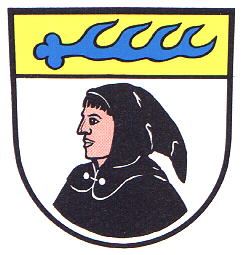Mönchweiler: Difference between revisions
Knorrepoes (talk | contribs) m (Text replacement - "{{media}}" to " {{de1}} {{media1}}") |
Knorrepoes (talk | contribs) m (Text replacement - "{{de}}" to "") |
||
| Line 1: | Line 1: | ||
'''MÖNCHWEILER''' | '''MÖNCHWEILER''' | ||
Revision as of 20:09, 26 December 2022
MÖNCHWEILER
State : Baden-Württemberg
District (Kreis) : Schwarzwald-Baar Kreis (until 1973 Villingen)
| German |
Unter goldenem Schildhaupt, darin eine blaue Hirschstange, in Silber ein wachsender Mönchsrumpf in schwarzem Habit. |
| English | No blazon/translation known. Please click here to send your (heraldic !) blazon or translation |
Origin/meaning
The arms were granted on April 15, 1922.
The oldest use of the arms date from 1811, when the arms appeared on the new seal of the local council. The monk's torso is a canting element (Mönch=monk). The deer antler in the chief is derived from the arms of Württemberg, to which the village historically belonged. In 1810, however, the village had become a part of Baden. The seal was used until the late 19th century, when it was replaced by a new seal showing a shield with a lion, derived from the State arms of Baden. In 1919 the old seal was restored and in 1922 were the arms officially granted.
Literature: John and Heine, 1989
